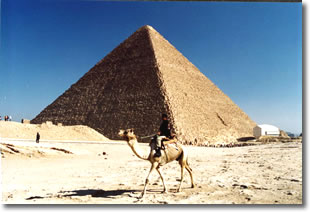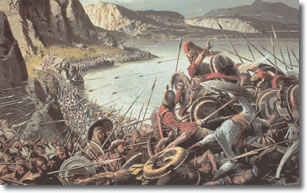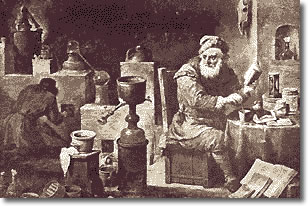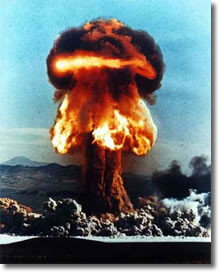A Historical Perspective of High Performing Teams
 At the dawn of human existence, it seems most probable that men organized themselves into cooperative groups of families - clans or tribes. Our primal needs are to be safe from predators, get enough food to eat, and perpetuate our species by nurturing and protecting our young. The tribe is much more effective at meeting these needs than individual families. A group or team of men (and women) could throw more rocks, or sharp pointed sticks, at a formidable creature than any one individual could working alone. Given varied intellect, imagination, physical abilities inherent in every group, it seems certain that when hunting or defending men quickly learned to specialize. The weaker or slower, made loud noises and perhaps postured aggressively or pranced around to herd game, while the quicker and stronger moved in for the kill or led the attacking vanguard. The victorious tribe now had food to eat, or more hunting territory in which to obtain food. Undoubtedly the successful tribes learned to share the food between the clan members. Probably on the basis of need the larger males receiving somewhat more food, the smaller children receiving less. Unless there was a surplus, in which case everyone ate until they were satiated. So the early tribes were most certainly communistic. Each contributing according to his ability, while each received food according to his need. In fact, communism remains the basis of most family behavior. At the dawn of human existence, it seems most probable that men organized themselves into cooperative groups of families - clans or tribes. Our primal needs are to be safe from predators, get enough food to eat, and perpetuate our species by nurturing and protecting our young. The tribe is much more effective at meeting these needs than individual families. A group or team of men (and women) could throw more rocks, or sharp pointed sticks, at a formidable creature than any one individual could working alone. Given varied intellect, imagination, physical abilities inherent in every group, it seems certain that when hunting or defending men quickly learned to specialize. The weaker or slower, made loud noises and perhaps postured aggressively or pranced around to herd game, while the quicker and stronger moved in for the kill or led the attacking vanguard. The victorious tribe now had food to eat, or more hunting territory in which to obtain food. Undoubtedly the successful tribes learned to share the food between the clan members. Probably on the basis of need the larger males receiving somewhat more food, the smaller children receiving less. Unless there was a surplus, in which case everyone ate until they were satiated. So the early tribes were most certainly communistic. Each contributing according to his ability, while each received food according to his need. In fact, communism remains the basis of most family behavior.
The communal nature of tribal life, however, does not present a superior model for the productive organization of businesses and governments. American Indian tribes have a tradition of sharing. Before the influences of western culture took hold, no individuals held personal or real property, most tribes shared game and produce not only among the other tribe members but often with other tribes. It was a major taboo to deny another food when requested, even if it meant you might go hungry yourself. George Loskiel, writing in 1794 noted that some Indian tribes of the northeast as being "so lazy that they plant nothing themselves, but rely entirely upon the expectation that others will not refuse to share their produce with them. Since the industrious thus enjoy no more of the fruits of their labor than the idle, they plant less every year." According to Will Durant writing in 1935, "Our Oriental Heritage", communism ends when danger subsides and luxury begins. At this point, social cohesion begins to dissolve and individualism increases.
 Farming contributed greatly to the concept of property, and hence individualism. Families and individuals who invest the time and energy in a plot of land began to think of it as belonging to them and them alone. Certainly throughout history strong men were able to impose their wills on others and exact a tax of all or part of the excess farm production. This phenomenon led to new societal models including slavery and the feudal system that arose in the middle ages. But over time the idea of property belonging to individuals won the day in most cultures. At the same time, the growth of trading between individuals and nations led to specialization of production for individuals, regions, and countries as well as the use coinage as a medium of exchange. With these two factors in play, it became possible for the brighter and more industrious to accumulate wealth and power without the need to resort exclusively to force: Farming contributed greatly to the concept of property, and hence individualism. Families and individuals who invest the time and energy in a plot of land began to think of it as belonging to them and them alone. Certainly throughout history strong men were able to impose their wills on others and exact a tax of all or part of the excess farm production. This phenomenon led to new societal models including slavery and the feudal system that arose in the middle ages. But over time the idea of property belonging to individuals won the day in most cultures. At the same time, the growth of trading between individuals and nations led to specialization of production for individuals, regions, and countries as well as the use coinage as a medium of exchange. With these two factors in play, it became possible for the brighter and more industrious to accumulate wealth and power without the need to resort exclusively to force:
"Then the race for wealth, goods, and power begins�and the pyramid of ability takes form once more; under whatever laws may be enacted the abler man manages somehow to get the richer soil, the better place, the lion's share." - Will Durant
Examples of High Performance Teams in History
Throughout time there have been countless examples of high performing teams who have achieved amazing results. Let's examine some teams and see what we can learn from them.
 One of the original seven wonders of the world, the
Great Pyramid of Giza, constructed around 2,650 BC, represents a clear example of sustained high performance teamwork by an estimated 100,000 workers over a span of 20 years. Composed of 2 million, 1.5 ton blocks of limestone, carried 500 miles the pyramid was originally 481 feet high with sides of 760 feet at its base. Begun an completed within the reign of the pharaoh Khufu (approximately 2,589 BC to 2,566 BC), the pyramid was either intended as a monument to Khufu's reign or his burial chamber. In any event, there is little doubt that this massive team worked with a "sense of urgency" to complete the project as quickly as possible. Though probably designed by a single priest/engineer, the shear scale and scope of the project strongly suggests a universally "shared vision" of the end result and wide-scale cooperation of planners in developing the methods to implement the vision and sustain the effort One of the original seven wonders of the world, the
Great Pyramid of Giza, constructed around 2,650 BC, represents a clear example of sustained high performance teamwork by an estimated 100,000 workers over a span of 20 years. Composed of 2 million, 1.5 ton blocks of limestone, carried 500 miles the pyramid was originally 481 feet high with sides of 760 feet at its base. Begun an completed within the reign of the pharaoh Khufu (approximately 2,589 BC to 2,566 BC), the pyramid was either intended as a monument to Khufu's reign or his burial chamber. In any event, there is little doubt that this massive team worked with a "sense of urgency" to complete the project as quickly as possible. Though probably designed by a single priest/engineer, the shear scale and scope of the project strongly suggests a universally "shared vision" of the end result and wide-scale cooperation of planners in developing the methods to implement the vision and sustain the effort
 In 480 BC Xerxes I, king of Persia, led an army variously estimated at between 300,000 and 6 million men into Greece on a campaign of conquest. Realizing the threat the Greeks, then organized into city states, sent a 5,200 volunteers to the mountain pass at Thermopylae in an effort to slow down Xerxes' army and give the rest of the Greeks the chance to pull a combined army together to meet the onslaught. Led by 300 Spartans, the Greeks were able to halt the Persian advance for 7 days. Enormous casualties were sustained by the Persians as the disciplined Spartans who seeking to maximize enemy casualties, orchestrated a series of feint retreats, followed by a quick turn back into formation. Coordinating this tactical maneuver, considering the chaos of battle, surely required extraordinary communication planning. We can easily imagine that other high performance team essential elements were present at well including: shared vision, out of their comfort zone, self-directed, involving everyone, and celebrating success. In 480 BC Xerxes I, king of Persia, led an army variously estimated at between 300,000 and 6 million men into Greece on a campaign of conquest. Realizing the threat the Greeks, then organized into city states, sent a 5,200 volunteers to the mountain pass at Thermopylae in an effort to slow down Xerxes' army and give the rest of the Greeks the chance to pull a combined army together to meet the onslaught. Led by 300 Spartans, the Greeks were able to halt the Persian advance for 7 days. Enormous casualties were sustained by the Persians as the disciplined Spartans who seeking to maximize enemy casualties, orchestrated a series of feint retreats, followed by a quick turn back into formation. Coordinating this tactical maneuver, considering the chaos of battle, surely required extraordinary communication planning. We can easily imagine that other high performance team essential elements were present at well including: shared vision, out of their comfort zone, self-directed, involving everyone, and celebrating success.
 In 1660, The Royal Society of London was formed to promote the free exchange of ideas and promotion of the "truth in scientific matters". Prominent members included Sir Isaac Newton, Christopher Wren (Architect of St. Paul's Cathedral), Gottfried Leibniz (inventor of calculus), Edmund Haley (astronomer), Robert Hooke (steam engine) to name but a few. The Society invited the membership of scientist regardless of nationality or the state of war which often existed between member countries. Members routinely submitted papers describing their findings which were in turn published to the rest of the members. In this fertile environment, in a mere 70 years the sciences of anatomy, zoology, chemistry, physics, astronomy, and botany were formed. The free flow of shared information between Royal Society members led directly to the industrial revolution, embryonic evolution theory, mechanical computation, the understanding of planetary gravity, and more. Perhaps in no other period of history has science moved so far, so quickly. The level of trust (truth, respect, understanding, support, and accountability) and shared vision (the goal to advance science) the members of the Society achieved, places them in my high performance team hall of fame. In 1660, The Royal Society of London was formed to promote the free exchange of ideas and promotion of the "truth in scientific matters". Prominent members included Sir Isaac Newton, Christopher Wren (Architect of St. Paul's Cathedral), Gottfried Leibniz (inventor of calculus), Edmund Haley (astronomer), Robert Hooke (steam engine) to name but a few. The Society invited the membership of scientist regardless of nationality or the state of war which often existed between member countries. Members routinely submitted papers describing their findings which were in turn published to the rest of the members. In this fertile environment, in a mere 70 years the sciences of anatomy, zoology, chemistry, physics, astronomy, and botany were formed. The free flow of shared information between Royal Society members led directly to the industrial revolution, embryonic evolution theory, mechanical computation, the understanding of planetary gravity, and more. Perhaps in no other period of history has science moved so far, so quickly. The level of trust (truth, respect, understanding, support, and accountability) and shared vision (the goal to advance science) the members of the Society achieved, places them in my high performance team hall of fame.
 Regardless of your thoughts on the end-result of the effort, the Manhattan Project (1942-1945) represents a clear example of a high performance team in action. At war with Germany and convinced that the German's were developing a nuclear weapon, the US launched to Manhattan Project in an desperate attempt to get there first. Clearly the team worked with an almost unimaginable sense of urgency. At the same time the Manhattan Project involved over 130,000 people, sworn to secrecy, in 13 different locations in the US. Extraordinary coordination and communication were required to make this mammoth project succeed. The scientist and engineers were working on a problem that no one knew how to solve. Clearly they were well outside of their comfort zones. And for the most part they were self-directed - how can you direct someone when no one knows how to do the work? Yet they achieved the desired result in a time-frame no one initially thought possible if they believed it could be done at all. I could make a similarly compelling case for the Apollo Moon Shot. Regardless of your thoughts on the end-result of the effort, the Manhattan Project (1942-1945) represents a clear example of a high performance team in action. At war with Germany and convinced that the German's were developing a nuclear weapon, the US launched to Manhattan Project in an desperate attempt to get there first. Clearly the team worked with an almost unimaginable sense of urgency. At the same time the Manhattan Project involved over 130,000 people, sworn to secrecy, in 13 different locations in the US. Extraordinary coordination and communication were required to make this mammoth project succeed. The scientist and engineers were working on a problem that no one knew how to solve. Clearly they were well outside of their comfort zones. And for the most part they were self-directed - how can you direct someone when no one knows how to do the work? Yet they achieved the desired result in a time-frame no one initially thought possible if they believed it could be done at all. I could make a similarly compelling case for the Apollo Moon Shot.
These are few prominent examples of historic high performance teams. Down through time have been thousands of others in virtually every field of human endeavor - some famous: The Stonewall Brigade, the 1969 Amazing Mets, 2005-2006 Pittsburg Steelers, to name but a few. And there will be others to come in the future. And they will achieve extraordinary results when the conditions are right, the vision is clear and, the need is sufficiently urgent.
The Implications for High Performance Teams
With this background we can conclude that in most instances people (workers, managers, and executives) are almost exclusively concerned with knowing what they will get for their efforts. Teamwork makes sense only when I expect to get more of what is important to me by being a team player than I would if I worked on my own.  This is murky ground because we do get something of value from being able to socialize with others in teams and of course our culture values teamwork and cooperation. And often the only way we can get our work accomplished is by working as teams. And yet most often organizations recognize us and reward us for our individual efforts and results not our team results. Both kinds of rewards and recognition are needed. To complicated matters, every high performance team is viewed as both elitist and a threat to the individuals not on the team. So if we are to work collectively we need to clearly understand what's in it for us as individuals and how the non-team members will be better off (because we are going need to convince them that they should cooperate with our efforts, or at least not sabotage them). We need to understand what it is that we are trying to accomplish as a team and how long we've got to accomplish it. We are also going to need to understand what kind of resources and support we can expect from above and the rest of the organization. In short we need a written charter, approved by the highest level executive who has complete responsibility for the organizational unit we will be changing. This is murky ground because we do get something of value from being able to socialize with others in teams and of course our culture values teamwork and cooperation. And often the only way we can get our work accomplished is by working as teams. And yet most often organizations recognize us and reward us for our individual efforts and results not our team results. Both kinds of rewards and recognition are needed. To complicated matters, every high performance team is viewed as both elitist and a threat to the individuals not on the team. So if we are to work collectively we need to clearly understand what's in it for us as individuals and how the non-team members will be better off (because we are going need to convince them that they should cooperate with our efforts, or at least not sabotage them). We need to understand what it is that we are trying to accomplish as a team and how long we've got to accomplish it. We are also going to need to understand what kind of resources and support we can expect from above and the rest of the organization. In short we need a written charter, approved by the highest level executive who has complete responsibility for the organizational unit we will be changing.
We live in a highly competitive world. Like communism, teamwork is most effective when the group's existence or prosperity is threatened by an external force and we fully account for the ambitions and desires of individuals. In the business world external threats occur frequently as when new competitors come on the scene and encroach on the firm's customer base (property?). The quickest way to bring about needed changes in how an organization functions and behaves is by direct orders from the top. Today most enlightened managers will eschew this approach as being counterproductive in the long run, recognizing that people do not like to be dictated to and will usually find a way to passively or actively resist. Instead of dictating change, or relying on the collective efforts of individuals acting alone, high performance teams offer the best hope for achieving rapid and successful results. Yet they must be carefully constructed and skillfully managed.
All businesses compete on the basis of cost, quality, or service. Of these three factors, cost is the easiest to measure and understand. Therefore high performance teams are most often created to find and implement cost reduction programs.  But cost reduction programs inevitably threaten the livelihood of other members of the organization and fewer people in a given department will mean less responsibility for managers. As a result, cost reduction teams, whose charters permit people reductions, will face great resistance from others in the organization. Only a strong leader at the top of the affected pyramid can force the grudging cooperation required to achieve real results. Each sub-organization sees others as more likely candidates for cost reduction or elimination. Resistance can be mitigated, to some degree, by beginning with a solid plan to re-train all displaced workers and move them into better/more valuable jobs. Management resistance can be reduced by promising and granting increased responsibility or income to managers who cooperate and aid the cost reduction effort. In an environment where managers and highly-trained workers can usually jump ship at will, people must share a positive vision of the future state of the organization and understand how they individually will benefit if they make the effort to cut cost. But cost reduction programs inevitably threaten the livelihood of other members of the organization and fewer people in a given department will mean less responsibility for managers. As a result, cost reduction teams, whose charters permit people reductions, will face great resistance from others in the organization. Only a strong leader at the top of the affected pyramid can force the grudging cooperation required to achieve real results. Each sub-organization sees others as more likely candidates for cost reduction or elimination. Resistance can be mitigated, to some degree, by beginning with a solid plan to re-train all displaced workers and move them into better/more valuable jobs. Management resistance can be reduced by promising and granting increased responsibility or income to managers who cooperate and aid the cost reduction effort. In an environment where managers and highly-trained workers can usually jump ship at will, people must share a positive vision of the future state of the organization and understand how they individually will benefit if they make the effort to cut cost.
The organization that perceives the external threat early enough has the luxury of focusing on customer service, quality, or both. Better service or quality will usually leads to more customers, more business and more gross profit. High performance teams that focus on these areas are much more easily accepted and supported by the rest of the organization but lack the sense of urgency that comes from knowing that your competitors are putting you out of business. The manager who sponsors a quality or service oriented team needs to make a strong credible case for the need to change and how this team and the rest of the organization will be rewarded if it achieves its objectives.
If history teaches us nothing else about teams, it is that members of organizations, working together, can create miracles, but that the conditions must be right for them to occur. Miracles are not accidents - they are the result of high performance teams that were carefully established, supported, and nurtured by management.
[Return to HPT Home Page]
Contact: [email protected]
Copyright (C) 2006, Donald J. Bodwell. All rights reserved.
|

